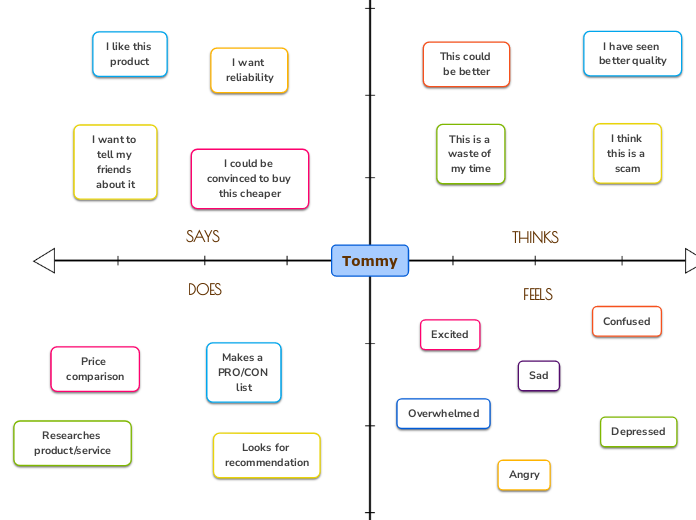Secondary behaviour
Primary behaviour
Customer assistance
Listening to customers
Strategic activities
Some companies go to extremes to involve the customer in every level of their business. This can be done by involving people of the same target group in the workforce, inviting customers to prospective employee interviews, and more.
Frontline personnel
To take full advantage of frontline employee’s interactions with customers, a company must train them to listen effectively and to make the first attempts at amends when customers have bad experiences.
Market research
Customers should be interviewed both at the time of arrival (when they become customers) and at the time of departure. Ask both “How did you hear about us?” (effectiveness of advertisement) but also “What major experiences influenced your decision to try our product or service?” (influencing factors). Carefully questioning departing customers is important for two reasons: to isolate those attributes of the company’s product/service that are causing customers to leave and to make a last-ditch attempt to keep the customer (surprisingly effective).
Feedback
Comments, complaints, and questions. A company cannot implement a recovery strategy – a plan for making amends when something has gone wrong – if it does not know who has had a problem.
Indices
Surveying customers about their level of satisfaction and plotting the results can help managers understand just how dis/satisfied customers are with their general dealings with the company and with various elements in particular. Useful for comparing results from different time periods, locations, etc.
Elements of customer satisfaction
Extraordinary services that makes product feel customized
Recovery process to counteract bad experiences
Basic elements of product/services
Basic upport services
Order tracking
Intent to repurchase
Word-of-mouth
Different satisfaction levels require different actions
Classification
Apostle/Terrorist
Loyalist
A customer who is completely satisfied and keeps returning to the company. They are the company’s bedrock. This customer’s needs and the company’s product or service offerings fit exceptionally well. However, when these customers become dissatisfied, they become very much so. Highly dissatisfied customers typically include people who were highly satisfied until they purchased a faulty product or suffered a service failure. If a company excels in making amends when such failures occur, customers’ faith in the company is not just restored, it is deepened; and they often become apostles.
Apostle
Loyalists who are so satisfied, whose experience so far exceeds their expectations, that they share their strong feelings with others.
The Mercenary
This individual defies the satisfaction-loyalty rule: they may be completely satisfied but exhibit almost no loyalty. These customers are often expensive to acquire and quick to depart. They chase low prices, buy on impulse, pursue fashion trends, or seek change for the sake of change. They never remain long enough for the relationship to turn a profit.
Defector
Includes those who are more than dissatisfied, quite dissatisfied, and neutral. The merely satisfied defect too. When a company has strong processes in place to understand such customers’ needs better and to shower attention, most of them can be converted once again into highly satisfied customers. Not all defectors should be retained, however. The unreasonable demands of happy customers whose needs do not fit with the company’s capabilities can devour excessive resources and destroy employee morale.
Terrorist
A customer who has had a bad experience and can’t wait to tell others about their anger and frustrating. Unfortunately, terrorists generally are far more committed and hence more effective at telling their stories than apostles.
The Hostage
Hostages are stuck. These individuals experience the worst the company has to offer and must accept it. Many companies operating in a monopolistic environment see little reason to respond to the plight of hostages. After all, these customers can’t go anywhere – so why bother? Two reasons:
1. Possible shift in competitive environment – then the company will pay the price. Their customers will defect quickly and many will become terrorists.
2. Difficult and expensive to serve – they may be trapped, but they still take every opportunity to complain and to ask for special service. They can devastate company morale, and their negative impact on per unit costs is high.
Measurement of loyalty
Results
Look for satisfaction improving variables
Monitor
Satisfaction over time
Comparisions with competitors (benchmarking)
Learn from the best
Advertisement
"8/10 dentists recommend Colgate"
Unit performance measure
Reliable survey only if answers consistent
Several related questions
Use multi item measures
Responts in hurry/unfocused
Risk of bad/untrue answers
Customers often overevaluate their satisfaction.
Identify with surveys
Match between expectations & perceived performance
Humans base future behaviour on previous experience
Post-consumption evaluation
Subjective
Attitudes, emotions & perceived quality
Internal, in the mind of customer
Complete customer satisfaction key to loyalty
Many managers choose to focus their efforts on understanding the group of least satisfied customers, since it is too expensive to change a relatively high customer rating to a perfect customer rating. Contrary to this popular belief, there is tremendous difference between the loyalty of merely satisfied and completely satisfied customers – the satisfaction-loyalty relationship is rarely linear. This is especially true in competitive markets, where any drop in satisfaction results in a major drop in loyalty.
Customer puts reputation on line
% promoters (9-10 rating) - % detractors (0-6 rating)
The one question you need to ask
"How likely is it that you would recommend X to a friend/colleague?"
Net promoter number
Loyalty matrix
Latent loyals
High mentality, low behavioural. Since they don’t display any activity, it’s easy to ignore them. This is a grave mistake, however, because there is already a strong sense of connection among these customers in that they represent a cost-efficient segment for marketing activities compared to customers with no particular connection at all. A hidden asset, as mentality can be transformed to behaviour.
Non-loyals
display low levels of loyalty in terms of both behaviour and mentality (defector)
True loyals
High behavioural, high mentality. (Loyalist)
False loyals
High behavioural, low mentality. Typical customer of this type faces a situation in which there are few alternatives (maybe monopoly), which means that few choices are available and the customer is forced to return. Risky to ignore, since they will leave if opportunity arises.
Switching barriers
"Satisfied customer is a loyal customer"
Oversimplified, satisfied customers aso defect
Customer loyalty
Loyal behaviour
Customer share
Depth
Volume
Frequency
Duration
Loyal mentality
Attitude
Positive/negative scale
Involvement
Personally relevant
Preferences
Intentions
Desire
Plan
Probability
Commitment
Is the relationship worth fighting for?
Emotions other than satisfaction e.g. joy
Customer satisfaction
Pleasant feelings are interpreted as evidence of liking, satisfaction, and well–being; unpleasant feelings are interpreted as evidence of disliking and dissatisfaction.
Very poor service or products are not the only cause – and may not even be the main cause – of high dissatisfaction. Often the company has attracted the wrong customers or has an inadequate process for turning around the right customers when they have a bad experience. Customers typically fall into one of two categories:
· Target group – whom the company should be able to serve well and profitably. Keep this group and strive to make amends when, inevitably, something goes wrong.
· Wrong customers – whose needs the company cannot profitably serve. Having wrong customers is the result of a flawed process for attracting or obtaining customers. The company that retains difficult-to-serve, chronically unhappy customers are making an expensive long-term mistake.









